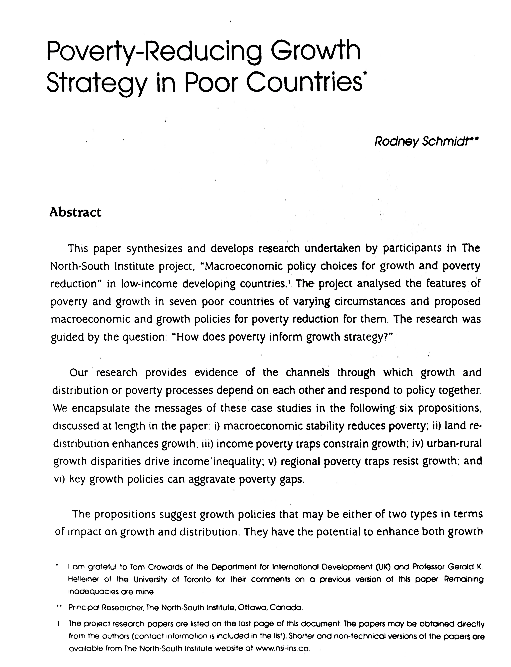Poverty-Reducing Growth Strategy in Poor Countries
DOI:
https://doi.org/10.35319/lajed.20050263Keywords:
Poverty reduction, Economic growth, PovertyAbstract
This paper synthesizes and develops research undertaken by participants in The North-South Institute project, "Macroeconomic policy choices for growth and poverty reduction" in low- income developing countries.1 The project analysed the features of poverty and growth in seven poor countries of varying circumstances and proposed macroeconomic and growth policies for poverty reduction for them. The research was guided by the question: "How does poverty inform growth strategy?"
Our research provides evidence of the channels through which growth and distribution or poverty processes depend on each other and respond to policy together. We encapsulate the messages of these case studies in the following six propositions, discussed at length in the paper: i) macroeconomic stability reduces poverty; ii) land redistribution enhances growth; iii) income poverty traps constrain growth; iv) urban-rural growth disparities drive income inequality; v) regional poverty traps resist growth, and vi) ley growth policies can aggravate poverty gaps.
The propositions suggest growth policies that may be either of two types in terms of impact on growth and distribution. They have the potential to enhance both growth and distribution (win-win) or to enhance growth while aggravating income gaps or vice versa (win-lose).
Downloads
References
Aghion. Philippe, Eve Caroli and Cecilia Garcia-Penalosa. 1999. “Inequality and economic growth: the perspective of the new growth theories”. Journal of Economic Literature XXXVII: 161 5-60.
Bigsten, Arne and Abebe Shimeles. 2003. “Prospects for ‘pro-poor’ growth in Africa”. Economic Commission for Africa, Economic Policy Research Center, Research paper ESPD/NRP/2003/4, available at www.uneca.org/eca_resources/Meetings_Events/espd/poorgrowth/.
Cashin, Paul, Paolo Mauro, Catherine Pattillo and Ratna Sahay. 2001. “Macroeconomic policies and poverty reduction: stylized facts and an overview of research”. IMF Working Paper 01/135. September.
Dutt, Pushan and Devashish Mitra. 2002. “Endogenous trade policy through majority voting: an empirical investigation”. Journal of International Economics 58: 107-33.
Easterly, William. 2002. “Inequality does cause underdevelopment: New evidence”. Center for Global Development. Working Paper 1. June
----------. 2001. The Elusive Quest for Growth. The MIT Press, Cambridge, Massachusetts and London, England.
Fischer, Ronald. 2001. “The evolution of inequality after trade liberalisation” Journal of Development Economics 66: 555-79.
Hanmer, Lucia, Niek de Jong, Rachel Kurian and Jos Mooij. 1999. “Are the DAC targets achievable? Poverty and human development in the year 2015”. Journal of International Development 11: 547-63.
Hirschman, Albert O. 1955. Strategy of economic development. Yale University Press, New Haven.
International Development Association and International Monetary Fund. 26 March 2002. “Review of the Poverty Reduction Strategy Paper (PRSP) approach: early experience with interim PRSPs and full PRSPs”.
Lundberg, Mattias and Lyn Squire. 2003. “The Simultaneous evolution of growth and inequality”. The Economic Journal 113: 326-44.
Marcus, Rachel and John Wilkinson. 2002. “Whose poverty matters? Vulnerability, social protection and PRSPs”. Childhood Poverty Research and Policy Centre. Working Paper 1.
Murphy, Kevin M., Andrei Shleifer and Robert Vishny. 1989. “Income distribution, market size, and industrialization”. The Quarterly Journal of Economics 104/3: 537-64.
Osmani, Siddiqur Rahman. 2000. “Growth strategies and poverty reduction”. Asian Development Review 18/2: 85-130.
Rodrik, Dani. 2004. “Growth strategies”. Manuscript, August, available at http://ksghome.harvard.edu/~drodrik/growthstrat10.pdf
Sachs, Jeffrey D. 1987. “Trade and exchange rate policies in growth-oriented adjustment programs”. In: V. Corbo, M. Goldstein and M. Khan (eds.). Growth-oriented adjustment programs (International Monetary Fund and The World Bank, Washington, D.C.).
Sen, Amartya. 2004. “Passage to China” The New York Review of Books. LI/19: 61-5.
Winters, L. Alan, Neil McCulloch and Andrew McKay. 2002. “Trade liberalisation and poverty: the empirical evidence”. CREDIT research paper 02/22. October.
World Bank. 2000. Rural Development Indicators Handbook (Washington, D.C.).
----------. 2001. World Development Report 2000/01: Attacking poverty (Oxford University Press, New York).
Yao, Shujie, Zongyi Zhang and Lucia Hanmer. 2004. “Growing inequality and poverty in China” China Economic Review 15: 145-63.






